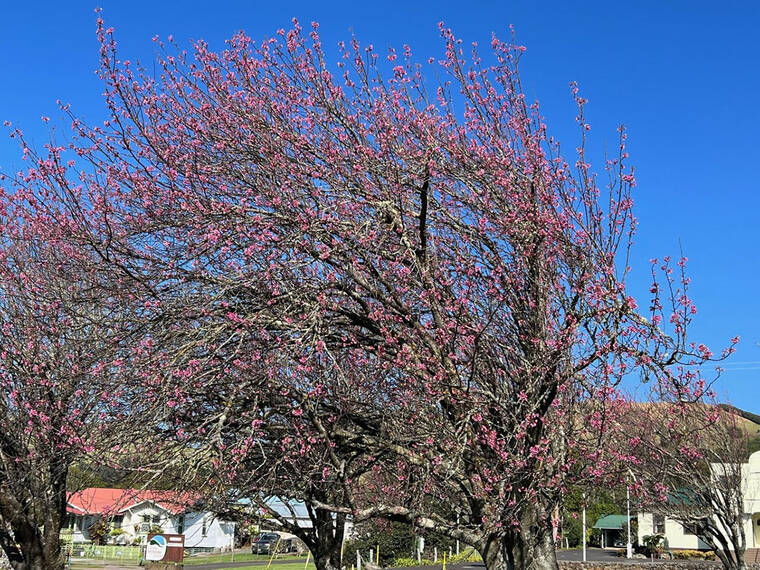Spring in the northern hemisphere officially starts on March 21, but in upland Hawaiian gardens, the budding cherry blossoms tell us spring is already here. In just one week we will celebrate the 30th Annual Cherry Blossom Heritage Festival. The official day of celebration will be Saturday, Feb. 4, but you can view these gorgeous trees beginning to bloom now.
There is quite a history when it comes to our cherry trees. The first big planting in Kamuela was in 1953 to commemorate and encourage the harmonious blending of Hawaiian and Japanese cultures.
This was particularly important since it was less than a decade after World War II. In Hawaii, folks were making every effort to heal the wounds of the past.
Viewing the beauty of awakening cherry trees has deep spiritual meaning and has been celebrated since the 7th century in Japan. There are many legends and myths associated with the cherry tree, or sakura, as it is also known. It represents rebirth, renewal, new beginnings and the start of spring. It is the central motif in the Japanese reverence for nature.
In Shinto and Buddhist folklore, the tree is said to hold spirits of those who have passed. Be aware that misfortune will follow those who cut down or mistreat a cherry tree.
Our upcoming Cherry Blossom Festival will not only be the viewing of the flowering trees but will include activities related to Japanese and Hawaiian culture. Plan on spending the day in Kamuela to visit shops and exhibits. There will be music and dance as well as an opportunity to see some examples of bonsai.
You may even get some ideas to bring Eastern garden design into your Hawaii garden. For details on events scheduled for the day, you may call Morty Carter Jr.
In Hawaii, China and Japan, rock and water are used to add interest to the garden. The stone water basins that usually stand outside the teahouses are an example of rock and water used on a small scale. Participants in the tea ceremony first wash their hands and at the same time, symbolically wash away the stain of the noisy and confused outside world. In almost any garden, and for whatever reason, the gentle sound and sight of water dripping over cool stones is refreshing.
The use of rock and water is becoming very popular for private patio landscaping. Here especially, we enjoy water splashing over rocks into shallow pools. We are fortunate to have a special mix of Eastern and Western culture in Hawaii. this allows us to create tropical gardens with the flavor of Japan, China, Bali or Thailand combined with the colonial plantation influence of the last century. Even in the smallest garden patio or condo lanai, we may even experience bonsai gardening.
Here in Hawaii, rocky land abounds. The tendency in the last 40 years was to bulldoze a building site flat and then landscape. Today, we are learning to appreciate rock forms, water elements and plants as sculpture. The Eastern influence of bonsai, Penjing and other cultural contributions like the Balinese reverence for banyan trees also contributes to our landscape awareness.
Several books are available to give you ideas on how to design and build your unique garden. Sunset Books has excellent basic publications that are available at bookstores and some garden shops. A beautiful book available at our local bookstores is “Tropical Asian Style.” There are a few books on Balinese gardens that are also good sources for ideas.
We live in one of the most unique places in the world where East meets West. Thus we celebrate the Hawaii Cherry Blossom Heritage Festival to remind us of the contributions of all the cultures represented here.






